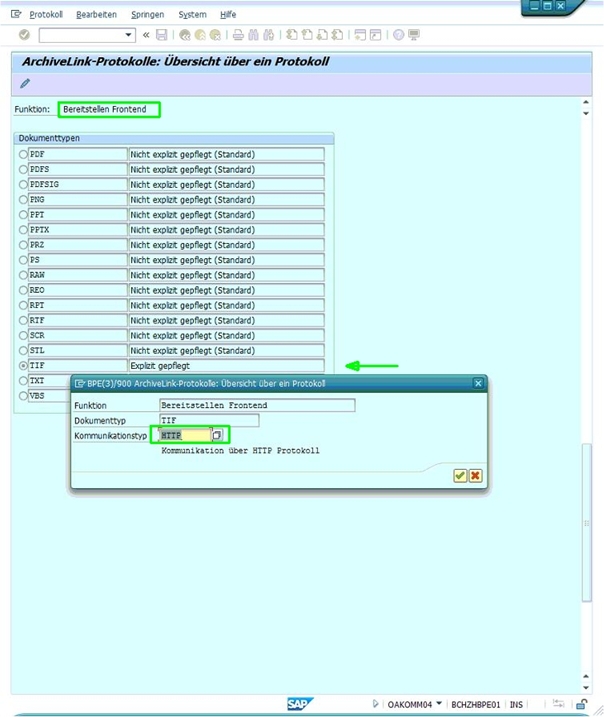Problema:
Los documentos de un sistema SAP deberían visualizarse. Pero se producen algunos problemas.
A) El documento debería visualizarse en el Visor ECL propio de SAP.
Aunque los documentos de Connect To SAP se pasan como .dwtiff y como tipo MIME image/tiff, la descarga del documento se realiza sin sufijo o con un sufijo falso (p. ej. .mdb).
B) El documento debería visualizarse en el navegador de Internet, sin embargo, los documentos se llaman en el cliente sin extensión de archivo al visualizar documentos de SAP y, por tanto, no se abren automáticamente en el visor adecuado. A menudo, el archivo sólo se "ejecuta".
Solución:
Antes de aplicar todas estas soluciones, asegúrese de que está instalado el último paquete de revisiones:
- DocuWare Versión 6.8 Hotfix 04
- DocuWare Versión 6.7 Hotfix 40
- DocuWare Versión 6.6 Hotfix 58
Para obtener estas revisiones, visite http://go.docuware.com/HFPacks.
Solución A.1) En DocuWare, compruebe en el archivo DWSAPHTTPServer.exe.config si la extensión del archivo está disponible (en su caso, ¿tal vez .dwtiff?). Los valores dwtiff=image/tiff o pdf=application/pdf por la opción SAPMimeTypes. En caso contrario, añada.
Ejemplo:
<add key="SAPMimeTypes" value="bin=aplicación/octet-stream|doc=aplicación/msword|pdf=aplicación/pdf|ps=aplicación/postscript|rtf=aplicación/rtf|xls=aplicación/vnd.ms-excel|mpp=aplicación/vnd.ms- project|ppt=aplicación/vnd.ms-powerpoint|msg=aplicación/vnd.ms-outlook|alf=aplicación/x-alf|otf=aplicación/x-otf|raw=aplicación/x-raw|reo=aplicación/x-reo|scr=aplicación/x-scr|bmp=image/bmp|gif=image/gif|jpg=image/jpeg|pcx=image/pcx|tif=image/tiff|dwtiff=image/tiff|html=text/html|txt=text/plain|note=aplicación/x-note|descr=aplicación/x-alf-descr"/>
Solución A.2) Compruebe los siguientes Ajustes de la 'Configuración de pantalla' en el SAP Server. Los Ajustes en el OAG4 y OAA3 están en una relación causal.
- Pruebe también la opción 'Data Provider Cache Disable '.
- Pruebe también la opción 'Llamar al navegador de Internet ' (el navegador del ordenador debe utilizarse para abrir el documento).
Transacción OAG4:

Transacción OAA3:
La versión debe ser 0045.

En este lugar el protocolo se utiliza sólo para el Repositorio de Contenidos 'FI'.
Dentro de ese protocolo se asignarán los tipos de archivo. Cada una de las tres funciones se ajustan ('Display Stored Document', 'Providing Frontend', ' Display Lokal File').

Para 'Display Stored Document "es el tipo de documento" TIF "asignado al tipo de comunicación" ARCHIVELNK ".

Para 'Proporcionar Frontend' es el tipo de documento 'TIF' asignado al tipo de comunicación 'HTTP'.

Para 'Mostrar Archivo Local' es el tipo de documento 'TIF' asignado al tipo de comunicación 'ARCHIVELNK'.

Solución B.1) Para ese tipo de archivo, ejecute una reasignación de la extensión de archivo al programa estándar de Windows.
http://windows.microsoft.com/de-de/windows/change-default-programs#1TC=windows-7

Solución B.2) En algunos casos, basta con actualizar la versión instalada de Microsoft Internet Explorer a la última versión y, a continuación, restablecer el nivel de seguridad de la zona de seguridad en cuestión a "predeterminado".
Solución B.3)Si existe un cliente en el que el documento puede visualizarse correctamente desde SAP, abra el registro de Windows* en este ordenador (Inicio > Ejecutar > "regedit") y entre en la clave "HKEY_CLASSES_ROOT\MIME\Database\Content Type".
Todos los tipos MIME de esta rama están asignados a una aplicación asociada.
Exporte la clave afectada por el tipo MIME defectuoso (por ejemplo, "image/tiff") desde este ordenador e impórtela en todos los clientes en los que no funcione la visualización.
Importe la clave del registro sólo en ordenadores con la misma versión del sistema operativo que el ordenador desde el que se exportó la clave.
El documento debería visualizarse ahora correctamente. Puede que sea necesario reiniciar Internet Explorer y SAPGUI después de realizar estos cambios.
* Nota: Los cambios en el registro de Windows pueden alterar la estabilidad y el funcionamiento de Microsoft Windows o de los programas y componentes instalados. Los cambios sólo deben realizarse con extremo cuidado y por personas experimentadas. DocuWare AG no asume ninguna garantía ni responsabilidad por errores causados por cambios en el registro en relación con este artículo de la Base de conocimientos o cualquier otra instrucción. Si tiene alguna pregunta sobre los cambios en el registro de Windows, póngase en contacto con Microsoft.
Tenga en cuenta: Este artículo es una traducción del idioma inglés. La información contenida en este artículo se basa en la(s) versión(es) original(es) del producto(s) en inglés. Puede haber errores menores, como en la gramática utilizada en la versión traducida de nuestros artículos. Si bien no podemos garantizar la exactitud completa de la traducción, en la mayoría de los casos, encontrará que es lo suficientemente informativa. En caso de duda, vuelva a la versión en inglés de este artículo.


